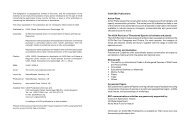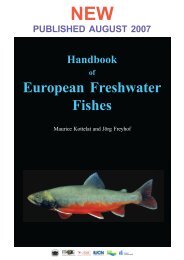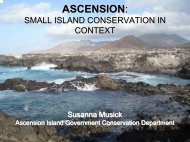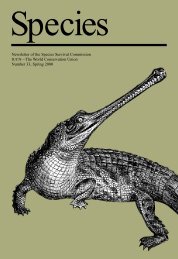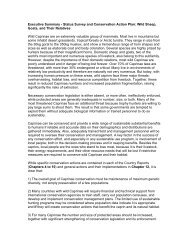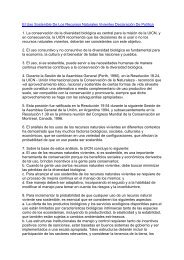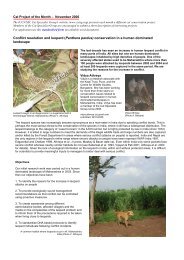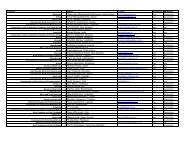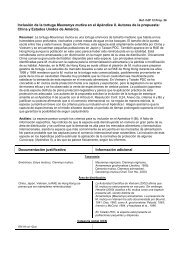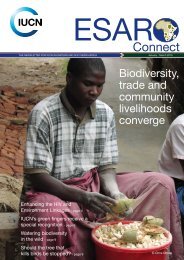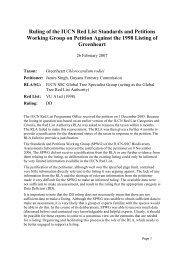Effects of <strong>education</strong> on seabird conservationDiscussionThe <strong>education</strong> programme promoted thoughtful, in<strong>for</strong>med, positivebehaviour (legal hunting, bird study) ra<strong>the</strong>r than focusing on s<strong>to</strong>ppingnegative behaviour (poaching). The programme did not try <strong>to</strong> introduceactivities that would be strangely new <strong>to</strong> <strong>the</strong> local culture (raising chickens,<strong>for</strong> example), recognizing that <strong>the</strong>re were good reasons why previousattempts had not taken hold. Ra<strong>the</strong>r than attempting <strong>to</strong> convince people thatit was wrong <strong>to</strong> kill birds, <strong>the</strong> programme acknowledged <strong>the</strong> basic culturalnorm: it is acceptable <strong>to</strong> harvest birds <strong>for</strong> an occasional meal, especially if<strong>the</strong>y are needed as food. (The need had in fact begun <strong>to</strong> decline with <strong>the</strong>introduction of freezers <strong>for</strong> food s<strong>to</strong>rage in <strong>the</strong> late 1960s, but it <strong>to</strong>ok <strong>the</strong><strong>education</strong>al programme <strong>to</strong> make evident this change.)O<strong>the</strong>r fac<strong>to</strong>rs helped <strong>to</strong> pass on <strong>the</strong> conservation message. Communityleaders influenced <strong>the</strong>ir peers, <strong>the</strong> children, and residents of o<strong>the</strong>rcommunities. The relative isolation of small communities meant that <strong>the</strong>rewas little competition <strong>for</strong> <strong>the</strong> good things a conservation programme offered.Children, <strong>for</strong> example, were anxious <strong>to</strong> take part in <strong>the</strong> St Mary’s Islandprogramme. People responded more <strong>to</strong> <strong>the</strong> norms of <strong>the</strong> group <strong>to</strong> which <strong>the</strong>ybelonged than <strong>to</strong> regulations, and spreading <strong>the</strong> message among peer groupswas more effective than posting signs or addressing large audiences.Although harvesting birds was <strong>the</strong> cus<strong>to</strong>m, <strong>the</strong> culture never<strong>the</strong>lesssupported <strong>the</strong> conservation principle that seabird populations be res<strong>to</strong>red <strong>to</strong>sustainable levels. Working with, ra<strong>the</strong>r than against, socio-cultural fac<strong>to</strong>rswas important so that <strong>the</strong> goals of both biological and cultural conservationcould be attained.Although <strong>the</strong> increase in en<strong>for</strong>cement contributed <strong>to</strong> <strong>the</strong> control of illegalharvest, as sociologists would point out, <strong>the</strong> introduction of extrinsicmotivation without regard <strong>to</strong> o<strong>the</strong>r fac<strong>to</strong>rs would have predictably failed <strong>to</strong>produce durable, long-term behaviour change (Katzev and Pardini 1987-1988). Fur<strong>the</strong>rmore, heavy-handed en<strong>for</strong>cement alone likely would havetriggered reactance, which induces behaviour in <strong>the</strong> opposite direction(Brehm 1966, Brehm and Brehm 1981). Evidence of this behaviour during<strong>the</strong> years immediately be<strong>for</strong>e <strong>the</strong> project began <strong>to</strong>ok <strong>the</strong> <strong>for</strong>m of occasionalnight raids <strong>to</strong> <strong>the</strong> seabird colonies <strong>for</strong> eggs (Blanchard and Monroe 1990).Sociologists agree that durable behaviour change requires <strong>the</strong> use oftechniques such as social commitment, intrinsic behaviour, and supportingattitudes (Heberlein 1981, DeYoung 1985-1986, DeYoung and Kaplan 1985-1986, Katvez and Johnson 1987).The conceptual framework <strong>for</strong> an <strong>education</strong> programme that targets aconservation problem in rural, less developed regions consists of four basicphases: research, planning, implementation and evaluation. This progressionallows <strong>for</strong> feedback, constructive decisions and modifications <strong>to</strong> future work.Research provides in<strong>for</strong>mation on <strong>the</strong> socio-cultural context that is necessary<strong>to</strong> develop <strong>education</strong> strategies. It assesses root causes of <strong>the</strong> problem,identifies audiences and opinion leaders, and leads <strong>to</strong> <strong>the</strong> development ofshared programme goals. In <strong>the</strong> planning phase, <strong>education</strong>al goals are45
<strong>Planning</strong> <strong>education</strong> <strong>to</strong> <strong>care</strong> <strong>for</strong> <strong>the</strong> ear<strong>the</strong>stablished and strategies planned. In <strong>the</strong> implementation phase, fac<strong>to</strong>rsincluding <strong>the</strong> style of presentation, <strong>the</strong> timing of activities, and <strong>the</strong> choice ofpeople <strong>to</strong> conduct <strong>the</strong>m are determined. Finally, evaluation measures <strong>the</strong>degree <strong>to</strong> which <strong>the</strong> <strong>education</strong>al aims and <strong>the</strong> overall management goals havebeen achieved.Too often, <strong>education</strong> programmes consist merely of planning andimplementation, without <strong>the</strong> solid foundation of research or <strong>the</strong> basis <strong>for</strong>difficult decisions based on an evaluation of per<strong>for</strong>mance.In a communication and <strong>education</strong> programme <strong>for</strong> wildlife conservation, keyrequirements include an investigation of <strong>the</strong> problem and its context fromboth biological and human points of view, <strong>the</strong> integration of <strong>the</strong> programmein<strong>to</strong> <strong>the</strong> overall management plan, cooperation with all <strong>the</strong> relevantconstituents, <strong>the</strong> inclusion of hands-on activities, leadership roles <strong>for</strong> localresidents, and evaluation from beginning <strong>to</strong> end.Several of <strong>the</strong>se features are found in <strong>the</strong> Quebec North Shore <strong>education</strong>programme. In particular, <strong>the</strong> success of <strong>the</strong> programme depended on six fac<strong>to</strong>rs:•Local residents, <strong>the</strong> wildlife agency and conservation groupsagreed on a common goal from <strong>the</strong> beginning.•Education was perceived as part of a comprehensive managementplan that included research, habitat protection and en<strong>for</strong>cement;<strong>the</strong> <strong>education</strong> programme contributed <strong>to</strong> a common resource goaland proceeded with agency support.•The <strong>education</strong> programme had four phases: research, planning,implementation and evaluation.•Local residents participated throughout <strong>the</strong> programme and localleadership roles were encouraged.•Activities were participa<strong>to</strong>ry and hands-on, with fun learningopportunities.•The programme included short- and long-term components; it haslasted <strong>for</strong> 17 years and has evolved <strong>to</strong> address related challenges,including those posed by economic development.The <strong>education</strong> programme did not place much emphasis on <strong>the</strong> indigenouspopulation of Montagnais Indians (14 percent of <strong>the</strong> local population), nordid it specifically target <strong>the</strong> worst poachers. The evaluation did not isolate<strong>the</strong> relative influence of o<strong>the</strong>r fac<strong>to</strong>rs (<strong>for</strong> example television, introduced in1979) in a controlled, systematic way. Evidence of <strong>the</strong> importance andsignificance of <strong>the</strong> <strong>education</strong> programme was, however, satisfac<strong>to</strong>rilyestablished.This Article is adapted from a longer treatment by K. A. Blanchardpublished in 1994: see references below.46



